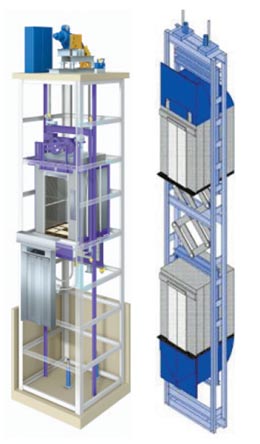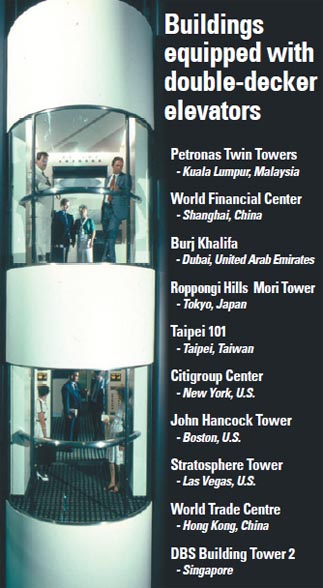Double-decker elevators coming

Single-decker / Double-decker
Double-decker look like two elevator cars attached to each other. As a result, the elevator visits two floors at the same time, raising the passenger capacity of the shaft. Double-decker elevators are already in use at the Petronas Twin Towers in Kuala Lumpur, Malaysia; the World Financial Center in Shanghai; and the Burj Khalifa in Dubai, the world’s tallest building, but there are none in Korea.
That will change in the coming years. Many other skyscrapers are also on the drawing board for Seoul - the Parc 1 tower in Yeouido, the DMC Landmark Tower in Sangam-dong and the Hyundai Global Business Center in Ttukseom - as well as the Songdo 151 Incheon Tower and Busan Lotte World tower.
“We are installing double-decker elevators for Lotte World II to reduce passenger waiting time and energy consumption and to improve efficiency,” said Lee Kang-hoon, a Lotte Group spokesman.

Double-decker elevators are used in tall towers, including the Burj Khalifa in Dubai, the tallest building in the world, to improve efficiency and bring down energy consumption. Another option is the twin elevator (not pictured), which joins two elevators side by side rather than vertically. Provided by Otis Elevator
Only a handful of foreign companies including Otis, ThyssenKrupp, Schindler and Mitsubishi have been able to commercially produce double-decker elevators so far, but Hyundai Elevator, Korea’s biggest elevator maker in terms of sales, has said it has finished the development of its own technology and would announce the results soon.
Double-decker elevators can usually move 600 meters (1,968.5 feet) per minute - quite fast compared to ordinary elevators in high-rise apartments, which travel 90 to 120 meters per minute. One reason for their rarity is cost, as a single unit can easily be priced at billions of won (millions of dollars).
“Double-decker elevators are twice as efficient in carrying passengers,” said Lee Mae-hee, a spokeswoman at Hyundai Elevator. “If regular elevators can carry 20 people at a time, they can take 40.”
Lee said the elevators are useful particularly for buildings with observation decks. “For famous skyscrapers, there are always many people in the lobby or the basement who want to go to observation decks on the top floors,” Lee said.
To increase efficiency further, often double-decker elevators are programmed to stop at only even- or odd-numbered floors.
Otis, the world’s No. 1 elevator producer, is interested in the local double-decker elevator market, according to Shin Yoon-young, a spokeswoman at Otis Elevator Korea. Otis developed the world’s first double-decker elevator in the 1930s, which was installed at the AIG building in Manhattan, New York. According to Otis, it now holds 90 percent of the double-decker elevator market in the world.
ThyssenKrupp Korea, the local subsidiary of Germany-based ThyssenKrupp, is offering another option. The company said its twin elevators are even more efficient than double-decker elevators. Twin elevators are already used in some local buildings such as the Korea Investment and Securities and Hyundai Capital headquarters, both in Yeouido, and the Trutec building in Sangam-dong, western Seoul.
Twin elevators pair units horizontally rather than vertically, with two elevators side by side. The hardest part of developing the system was to prevent two elevators moving in the same shaft from crashing into each other. With twin elevators, passengers press the button for what floor they want before they enter, after which the system notifies them of which elevator to take. Passengers often have to transfer to another elevator to reach the floor they want.
“Twin elevators are even more efficient than double-decker elevators and can save building space and construction costs,” said Ryu Ji-yong, a marketing manager at ThyssenKrupp Korea.
By Limb Jae-un [jbiz91@joongang.co.kr]










with the Korea JoongAng Daily
To write comments, please log in to one of the accounts.
Standards Board Policy (0/250자)